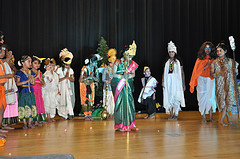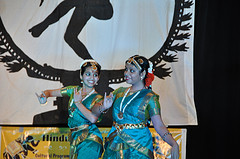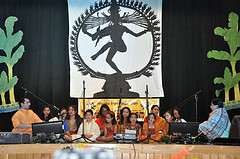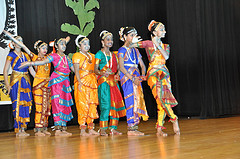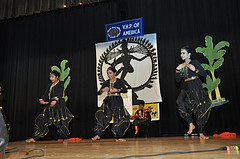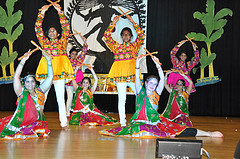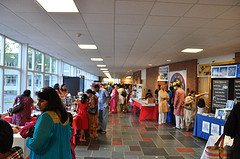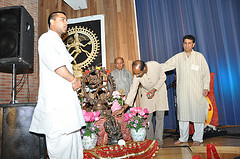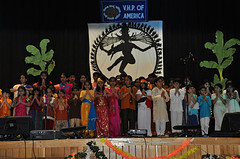Contribute
| Hindu Heritage Day Mela 2012 |
Press Release
05/24/2012
Close to 1500 Hindu Americans assembled at the Marlborough Middle School in Massachusetts on 19 May 2012, to celebrate the 16th Annual Hindu Heritage Day Mela (HHD), which was organized in the form of a fair, by the Vishwa Hindu Parishad (World Hindu Council) of America (VHPA). VHPA [http://www.vhp-america.org] is a national organization aiming to unite Hindus by instilling in them devotion to the Hindu way of life, to cultivate self-respect and respect for all people, and to establish contacts with Hindus all over the world. To mark this annual occasion, the Governor of the Commonwealth of Massachusetts, Mr. Deval L. Patrick, as well as the Mayor of the City of Marlborough, Ms. Nancy E. Stevens, proclaimed Saturday, 19 May 2012 as "Hindu Heritage Day."
The theme of this year’s celebration was “Krishna Leelaâ€. This theme is close to the heart of every man who has a soft spot for India and Indian philosophy. Man is born, lives, and dies engaged in relationships within a family structure. Sri Krishna, approximately 5,000 years ago, amply demonstrated during his 12 years of childhood stay in Vrindavan that family is more than blood relations and encompasses the interconnected family of all beings and non-beings. Sri Krishna, through His Leela or sportive play, has shown mankind how to relate to and honor all relationships: the divine as well as the worldly, including those with animals, plants, and even rocks.
For those people attending HHD for the first time, the “mela,†akin to a typical country fair, was a surprise as it was unlike any event they had experienced elsewhere. They wondered how it could even begin to be managed. The mela was composed of three major programs that ran simultaneously. First, there was a cultural program that ran for over three hours. Second, there were more than 40 booths in the form of a bazaar that one could visit and browse. Third, there was a food court where one could find the popular delights from the northern and southern regions of India. A nominal entrance fee of $3 per person, exempting children 5 and younger, covered admission to the entire event.
Almost all attendees had to seek a trade-off among the three options to attend and benefit from all the programs in the available time without missing anything. An important aspect for almost all of the people was meeting friends, some of whom they had lost touch with, and making new friends. It became a juggling act on the part of each family to enjoy the available events. At the end of the evening, almost everyone wished that they had come earlier or had more time to do everything.
The cultural program featured more than 200 performing participants from 18-plus organizations. It allowed children of all ages to perform on stage. It was geared to be an open house program where the audience was free to go in and out of the auditorium as long as it was done discreetly without disrupting the performers or the attendees. The program brought together the work of the best music and dance teachers of the Boston metropolitan area. Overall, more than 25 performances were presented by those teachers. Each item was professionally done, complete with appropriate costumes under the expert guidance of the teachers. It was with pride that the teachers presented their student performances and it was with wonder that the audience watched these presentations by the talented youth.
The program also featured 2 plays, one based on the life of Krishna, showcasing three episodes from his life, from his boyhood in Gokul to his life as an adult king in Dwarka. The central theme of the play was that Bhakti or devotion was the highest value that one could strive for. The second play was the “Churning of the Milky Ocean†or “Samudra Manthan.†This play depicts one of the Avatars of Vishnu. The story represents the spiritual endeavor of the human mind for gaining immortality through concentration, withdrawal of senses, control of desires and practice of asceticism. The Gods represent the positive and the Asuras the negative thoughts, the ocean represents the human consciousness.
In the span of the 16-year history of the HHD, the demand for a slot in the program far outstrips the availability. The logistics of getting all of the participants ready in the green room, ensuring that the right computer disc is played for a respective performance, and getting the sound system and stage lighting to run smoothly is a performance in its own merit perfected by a number of volunteers over the last several years.
While the cultural program ran in the auditorium, there was a virtual bazaar established in the corridors. Two categories of booths or stalls were there. One was for-profit and sold merchandise from India not easily available in stores in the Boston metropolitan area. This category included garments, jewelry, books, and various decorative items. The mehndi (Henna) stall was very popular with young ladies regardless of their level of familiarity with the natural cosmetic of Bharat, and children loved the face-painting booth. There was also a DJ who played catchy and popular songs throughout the afternoon. The second category of booths was of not-for-profit organizations offering information useful to the community at large. Contact information was available for various schools of yoga and meditation, VHPA camps, instruction in learning Sanskrit and Hindi, “Indian Circle for Caring,†temples in the region, Math and Science teachers, “Ekal Vidyalaya,†“Support-a-Child,†and financial services, to list a few. It took considerable time to navigate these booths as one ran across friends and time had to be taken to chat with several families. Without the HHD, many such friends often need an extra motivation to meet and greet.
The increasing popularity of the HHD could be gauged from the large attendance in spite of the beautiful weather. Such a sunny day easily pulls people in the directions of other outdoor attractions. However, the sunny day enhanced the most popular activity of the mela, the kite-flying. At least 40-50 people took advantage of the free kites that could be flown. There were a minimum of 6-8 kites up in the air simultaneously at any given moment.
The hallway also featured two highly informative yet easy-to-understand exhibits. One was about the "Giants of the Bhakti Movement in Medieval India". It featured the biographies of saints whose selfless service helped Hinduism withstand the turbulence of the times, throughout the history of India. The other was about the "Significance of the First Ten Numbers in Hinduism". To many children born in this country, it was a "crash course" on the core concepts of Hinduism.
Besides the booths, the cafeteria was a common area where one was certain to run into friends. It was crowded at all times. A prominent Indian restaurant, Minerva, of Natick, MA, served the food. The fragrance of freshly prepared food wafted through the air as the kitchen staff worked non-stop to keep up with the demand for various items. One was reminded of weddings in India where such activity to feed a virtually unlimited number of guests is commonplace.
Behind the scenes, there were over 50 volunteers that worked, some of them over several months, to make the HHD mela possible and successful. Many of such volunteers have been working for organizing the HHD since its beginning in the Boston metropolitan area. If you are interested in participating in any segment of the HHD next year, please contact Mrs. Jaya Asthana at jasthana@hotmail.com or hhdboston@gmail.com.
You may also access this article through our web-site http://www.lokvani.com/
